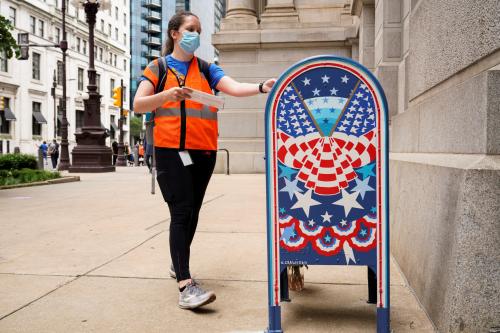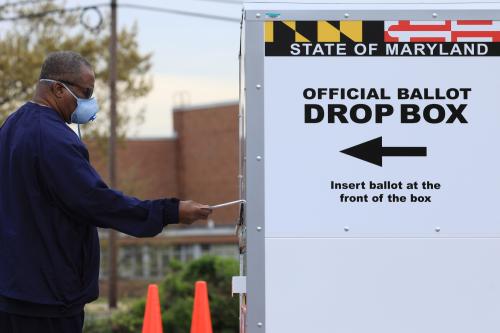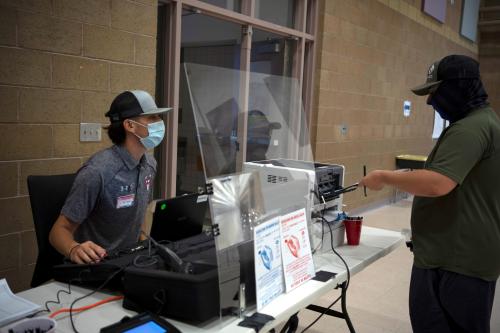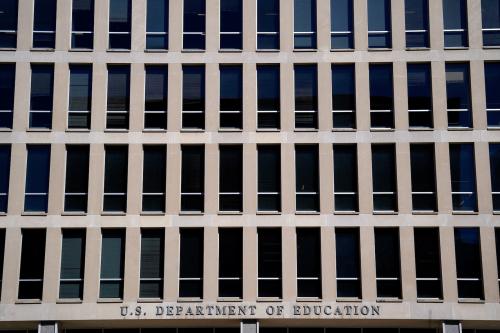In mid-July we published a scorecard evaluating each state’s vote-by-mail system in the context of a pandemic. Since then, some states have changed their election laws to accommodate the ongoing pandemic and to make it easier to vote by mail. So now, with the conventions over and the start of the general election, we thought it would be a good time to look at the improvements that have been made over the summer.
We start with what are called “universal vote-by-mail” states. In these states, a voter does not need to request an absentee ballot—an actual ballot is mailed to every registered voter. President Trump is especially hostile to these states, repeatedly asserting, without evidence, that these election systems are vulnerable to fraud. But that has not deterred some states from moving in this direction.
Back in July there were seven states (including the District of Columbia) in this category and as of this writing that number has grown to ten with the addition of Vermont, Nevada, and New Jersey—states with both Democratic and Republican governors and secretaries of state. New Jersey is an example of how far some states have come. In addition to sending out ballots to every registered voter, and in recognition of the fact that the U.S. mail might be slow, New Jersey will accept ballots as much as a week after Election Day and voters will be given the option to hand in their ballots in person. Most importantly, Governor Phil Murphy (D) has mandated that at least 50% of each counties’ polling places be open. Having a sufficient number of polling places is an important fail-safe mechanism in vote-by-mail states.
The Trump campaign filed suit against New Jersey, alleging that the governor didn’t have the power to change the election by executive order. They had previously filed similar suits in Nevada and California but in those states the governor’s orders were subsequently followed up by legislative action codifying the new systems.
The remainder of the states allow absentee ballots, with varying rules and restrictions. One of the categories where several states made improvements was in how to ask for an absentee ballot. Many states require no excuse at all to get an absentee ballot. There are currently 17 no-excuse absentee ballot states. Of the remaining states, Alabama, Connecticut, Kentucky, and New York, recently added fear of COVID–19 to the list of permissible excuses a voter can provide to get an absentee ballot. These states also have governors and secretaries of state from both parties. The state of West Virginia recently ruled that “Due to Concerns of COVID-19 all voters may apply to vote absentee in the 2020 General Election because of ‘medical reason’”. So although there are still excuses listed on the application form, the Secretary of State is allowing everyone to apply for an absentee ballot essentially without an excuse.
Nebraska and Iowa decided to send an absentee ballot application to every registered voter—bringing the number of states that automatically send out applications to 10.
Two states, Minnesota and Nevada, extended their deadlines for when ballots can be received. These changes could be crucial, given that the USPS sent a letter to 46 states this month warning that “deadlines for requesting and casting mail-in ballots are incongruous with the Postal Service’s delivery standards.” In Minnesota and Nevada ballots will be counted if they are received 7 days after election day. In Pennsylvania the Secretary of State Kathryn Boockvar has asked the court for permission to make changes to the election law which include extending the deadline for ballots to be counted. The case will be heard in the week after Labor Day. But in 5 other states considered competitive, including Arizona, Florida, Georgia, Michigan, and Wisconsin, ballots are still due by the close of polling on Election Day, despite USPS’s warning that on-time delivery may not be operationally feasible. Taken together, these states represent nearly 15% of the Electoral College votes, so how many ballots they accept could be pivotal to the outcome of this election.
Since we first published the scorecard, concern about the November elections has increased. There are worries about the ability of the Post Office to deliver absentee ballot application forms and ballots on time. There are worries about whether one’s vote will be counted. And there are worries about the ability of states to count votes in a timely manner.
These worries are real, but there are protective measures in place in many states and it’s not too late for other states to join them. For instance, as noted above, 10 states now send absentee ballot applications out automatically to all registered voters. This is very important because the voter doesn’t have to remember to ask for a ballot. Second, 22 states now have plans to count ballots that come in after Election Day, as long as they are postmarked by Election Day—a practice similar to the IRS rules about who is late filing taxes and who is on time. This, too, is important since it protects the voter against slow mail delivery. And finally, states are committing to opening many if not all traditional polling places for people who prefer to vote in person or who distrust the integrity of the vote-by-mail system. Ensuring in-person polling sites will be a necessity for the November election. It is inevitable that voters will miss the vote-by-mail deadlines or just prefer to vote in-person.
The United States has always managed to hold elections, even in time of war, and allows deployed soldiers to vote by mail. While some states are moving in the direction of adapting their elections to our new normal, time is running out for the rest of the states to meaningfully change policy. If states and localities fail to act, the pandemic-related complications we saw throughout the primaries could undermine Americans’ trust in a fair vote count. With little assistance forthcoming from the federal government, states should learn from their experiences in the primaries, and from each other, and work aggressively now to ensure a fair election in November.
The Brookings Institution is committed to quality, independence, and impact.
We are supported by a diverse array of funders. In line with our values and policies, each Brookings publication represents the sole views of its author(s).











Commentary
Is it getting easier to vote by mail?
September 2, 2020